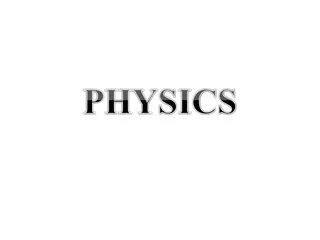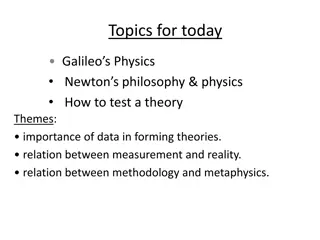Understanding Interpolation Methods in Physics
Interpolation in physics involves constructing a function that fits known data points to estimate values at arbitrary points. It is a method to fill in data gaps and is a specific case of curve fitting. Linear interpolation and polynomial interpolation are common methods used in this process, each with its advantages and limitations. Choosing the right interpolation method requires considering factors like accuracy, cost, smoothness, and data points needed.
Download Presentation

Please find below an Image/Link to download the presentation.
The content on the website is provided AS IS for your information and personal use only. It may not be sold, licensed, or shared on other websites without obtaining consent from the author. Download presentation by click this link. If you encounter any issues during the download, it is possible that the publisher has removed the file from their server.
E N D
Presentation Transcript
6.2 Interpolation and Extrapolation Interpolation is a method of new data points from a discrete set of knows data points. In Physics Obtained a number of data points by sampling or some experiment, and tries to construct a function which closely fit these data points. This is called curve fitting. Interpolation is a specific case of curve fitting We sometimes know the value of a function f(x) at a set of points x1,x2, ,xN, but we don t have an analytic expression for f(x) that lets us calculate its value at an arbitrary point. For example the f(x) s result from some physical measurement that can be cast into a simple function form.
If the desired x is in between the largest and smallest of the x s, the problem is called interpolation; if x is outside the range it is called extrapolation. Interpolation process has two stages: Fit an interpolation function to the data points provided. Evaluate that interpolation function at the target point x . The number of points used in an interpolation scheme is called the order of the interpolation. Increasing the order does not necessarily increase the accuracy, especially in polynomial interpolation.
Example: Suppose we have a table like this, which gives some values of an unknown function f X f(x) 0 0 1 0.8415 2 0.9093 What value does the 3 0.1411 function have at, x=2.5? 4 -0.7568 Interpolation answers questions like this 5 -0.9589 6 -0.2794 There are many different interpolation methods, some of which are described below. Some of the things to take into account when choosing an appropriate algorithm are: how accurate is the method? How expensive is it? How smooth is the interplant? How many data points are needed?
6.2.1 Linear interpolation One of the simplest methods is linear interpolation. Consider the above example of determining f (2.5). Since 2.5 is midway between 2 and 3, it is reasonable to take f(2.5) midway between f(2)=0.9093 and f(3)=0.1411, which yields 0.5252. Generally , linear interpolation takes two data points, say (xa,yb) and (xa,yb) and the interplant is given by This formula can be interpreted as a weighted mean. Linear interpolation is quick and easy, but it is not very precise Polynomial interpolation is a generalization of linear interpolation. Note that the linear interpolant is a linear function. We now replace this interpolant by a polynomial of higher degree.
Consider again the problem given above. The following sixth degree polynomial goes through all the seven points: Substituting x=2.5, we find that f(2.5)=.5965. Generally, if we have n data points, there is exactly one polynomial of degree n-1 going through all the data points.
6.2.2 Polynomial interpolation and extrapolation The interpolating polynomial of degree N-1 through the N points y1=f(x1) , y2=f(x2), ., yN=f(xN) is given by Lagrange s classical formula
There are N terms , each a polynomial of degree N-1. Let p1be the value at x of the unique polynomial of degree zero passing through the point (x1,y1); so p1=y1. Also, define p2,p3,..,pN. Now, let p12be the value at x of the unique polynomial of degree one passing through both(x1,y1)and(x2,y2).Likewise p23,p34,..,p(N-1)N. Similarly, for higher-order, up to p123 .N, which is the value of the unique interpolating polynomial through all N points?
The computational procedure used in computer software for the evaluation of a library function such as sin(x), Cos(x) or ex involves polynomial approximation. Suppose that the function f(x) =exis to be approximated by a polynomial of degree n=2 over the interval [-1, 1]. The Taylor approximation p(x) =1.0+1.0x+0.5x2. An associated problem involves the construction of the collection polynomial. Given n+1 points in the plane, the collection polynomial is the unique polynomial of degree n which passes through the points. For example, the collection polynomial of degree n=4 that passes through the five points (1,2),(2,1),(3,5),(4,6) and (5,1) is: P(x)=[504 - 806x + 427x2- 82x3+ 5x4]/24
6.2.3 Taylor series and Lagrange approximation Taylor series expansion of some functions can be expressed as: Sin(x)=x - [x3/3!] + [x5/5!] - [x7/7!] + .. Also, cos(x), exp(x), ln(1+x) Linear interpolation uses a line segment that passes through two points. The slope between (x0,y0) and (x1,y1) is m=(y1-y0)/(x1-x0), and the point- slope formula for the line y=y0+m(x-x0) can be rearranged as: y=p(x)=y0+(y1-y0)(x-x0)/x1-x0) Evaluation of p(x) at x0and x1produces y0and y1respectively P(x0)=y0+(y1-y0)=y0and P(x1)=y0+(y1-y0)1=y1 Lagrange used a different method to find this polynomial and can be written as y=p1(x)=y0 [x-x1]/[x0-x1] +y1[x-x0]/[x1-x0] (1) The quotients in (1) are denoted by L1,0(x)=[x-x1]/[x0-x1] and L1,1(x)=[x-x0]/[x1-x0]
The terms L1,0(x) and L1,1(x) are called the Lagrange coefficient polynomials. Eq(1) can be written as p1(x) = k=o1ykL1,k(x) (2) The generalization of Eq.(2) is the construction of a polynomial pN(x) of degree at most N that passes through the N+1 points (x0,y0), (x1,y1), .(xN,yN) and has the form Where LN,k(x) is the Lagrange coefficient polynomial based on these nodes
Where LN,kis the Lagrange polynomial based on these nodes:
6.2.4 Newton Polynomial It is sometimes useful to find several approximating polynomial p1(x), p2(x), pN(x) and then choose the one that suits our needs. We take a new approach and construct Newton polynomial that have the recursive pattern Example (1) For example, suppose we have a table like this, which gives some values of an unknown function f
6.3 METHODS FOR EQUATIONS IN A SINGLE VARIABLE The methods described in this section are aimed at solving equations that contain a single variable. We assume that the equation to be solved is written in the form A root of the general equation in Eq. [6.3.1] is a value of x that satisfies the equation; methods for solving the equation are thus called root-solving methods.
6.3.1 The incremental-Search method The incremental-search method is a numerical analog of finding a root of Eq. [6.3.1] by plotting f(x) versus x to see where f (x) crosses the x axis. The procedure is as follows. Procedure of incremental-search method: 1. Set a counter I to zero, choose a starting value x0, choose an increment h, and compute a reference value f0, equal to f (x0). 2. Increase I by 1, set xi equal to (x0+ ih), and compute f(xi). 3. If {f0[f(xi)]}>0, return to Step 2; otherwise, go on to Step 4. 4. Estimate the root x from: x = xi h [f(xi)]/[ f(xi)- f(xi-h)].
The idea in procedure 6.3.1 is to begin at a starting point x0and search along the x axis in the increments h until we find two successive points (xi h) and xiwhose line segment contains a root. This segment is indicated when the function first becomes zero or changes sign; that is, when the product [f0f(xi)] first becomes less than or equal to zero. The root is then estimated by linear interpolation in Step 4. The magnitude of the increment h represents a crude error bound for the estimated solution because it is the length of the segment on which the exact solution lies. The sign of h dictates the search direction from the starting point x0. If no solution exists in that direction, the method will obviously fail. The number of iterations should be limited to prevent infinite looping in such an instance. Failure and infinite looping can also occur when h is large in magnitude and the equation has two closely spaced roots. If the line segment from (xi-h) to xicontains both roots, the function values at the search points would have the same sign. The test of Step 3 would then fail to indicate the presence of the roots. Another condition that may cause failure is a discontinuity. Consider for example, the function
The function is discontinuous when x is equal to 1. It tends to (- ) as x approaches 1 from above, and it tends to (+ ) as x approaches 1 from below. Application of incremental search procedure to solving f(x) = 0 could cause the existence of a root to be falsely indicated when two search points lie on the opposite sides of (x = 1). To illustrate the incremental search method, we consider the deflection of a horizontal cantilevered beam when it is subjected to a uniform, vertical load. Abeam extending from its clamped end (x = 0) to its free end (x = L) has a maximum deflection maxat (x = L). The deflection at the location (x = L) is related to maxby
The determination of for a given value of / maxin the range (0 / max 1) is shown in the following Example:























